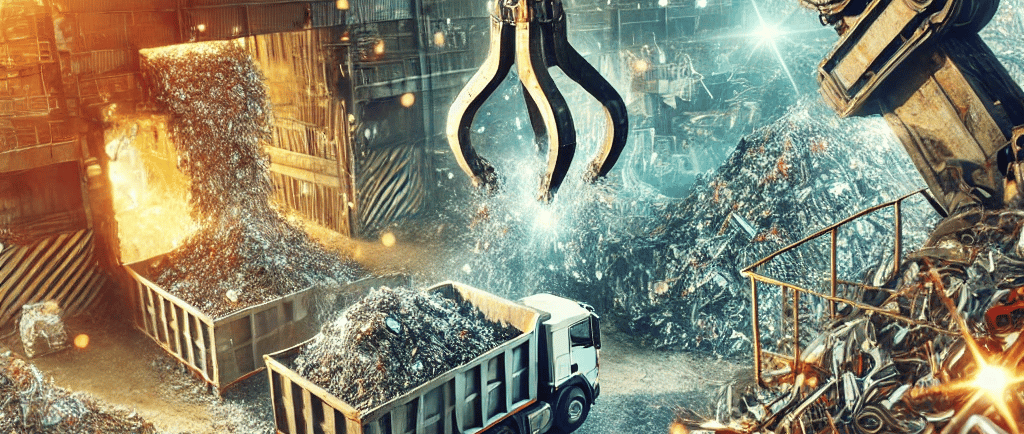How Scrap Metal Recycling Drives Sustainability and Economic Growth
Discover how scrap metal recycling supports sustainability by reducing emissions, conserving natural resources, and promoting economic growth. Learn how businesses can leverage this industry for long-term success.
SUSTAINABLE METALS & RECYCLING INNOVATIONS


Scrap metal recycling plays a vital role in advancing global sustainability while fostering economic growth. As industries transition toward circular economies, recycling metals helps reduce environmental impacts, conserve resources, and enhance industrial efficiency. Furthermore, the United Nations Sustainable Development Goals (SDGs) highlight the importance of responsible resource use, making scrap metal recycling a key contributor to SDG 9 (Industry, Innovation, and Infrastructure), SDG 12 (Responsible Consumption and Production), and SDG 13 (Climate Action).
This blog explores how scrap metal recycling supports sustainability, benefits economic development, and positions stakeholders for long-term success.
The Value of Scrap Metal Recycling
Metals such as aluminum, copper, and steel can be recycled indefinitely without losing their properties, making them highly sustainable materials. Unlike single-use plastics or glass, metals retain their durability across recycling cycles, making them essential in various industries.
Key Benefits of Metal Recycling:
✅ Energy Efficiency – Using recycled metal reduces energy consumption by up to 95% compared to mining and refining virgin ore.
✅ Waste Reduction – Millions of tons of scrap metal are generated yearly; recycling keeps valuable materials out of landfills and reduces environmental damage.
✅ Economic Growth – The metal recycling industry supports millions of jobs worldwide, from scrap collection to refining and trading.
✅ Lower Carbon Footprint – Mining activities generate vast amounts of CO₂; recycling significantly reduces greenhouse gas (GHG) emissions.
Recycling metals promotes sustainability while ensuring steady raw material supply for major industries such as construction, automotive, electronics, and manufacturing.
How Scrap Metal Recycling Aligns with the UN Sustainable Development Goals
1. SDG 9: Industry, Innovation, and Infrastructure
Sustainable industrialization is essential for long-term economic resilience. Scrap metal recycling contributes by:
- Maximizing Resource Efficiency – Reducing dependency on virgin mineral extraction lowers costs and environmental impact.
- Encouraging Innovation – Advancements in metal sorting and processing technologies streamline recycling processes, making operations more efficient.
- Enhancing Supply Chains – Many industries, especially construction and automotive sectors, increasingly rely on sustainable metal sources.
Example: Many construction projects now source recycled steel and aluminum to align with green building standards, reducing material costs and improving energy efficiency.
2. SDG 12: Responsible Consumption and Production
Sustainable consumption requires industries to minimize waste and optimize resource use. Metal recycling effectively achieves this by:
- Reducing Scrap Waste – Millions of tons of metal waste enter landfills yearly. Recycling reduces environmental strain and improves material circulation.
- Lowering Hazardous Emissions – Mining and smelting processes release toxic pollutants; using recycled materials minimizes these harmful effects.
- Promoting Circular Economies – Unlike linear manufacturing models, closed-loop metal recycling ensures long-term sustainability.
Example: Electronics manufacturers are now focusing on repurposing e-waste, ensuring metals from discarded smartphones, laptops, and household appliances are reintegrated into production cycles.
3. SDG 13: Climate Action
Climate change mitigation depends on lowering global CO₂ emissions, and recycling metals plays a vital role in emission reduction. How?
- Energy Conservation – Processing recycled aluminum uses 95% less energy than refining new aluminum from bauxite.
- Lower Carbon Emissions – The steel industry alone generates 7% of total CO₂ emissions globally; recycled steel cuts these emissions substantially.
- Preserving Natural Resources – Mining leads to deforestation and water pollution—scrap recycling alleviates ecological damage.
Example: The EU aims to recycle >80% of its metal packaging waste by 2030, reducing emissions and optimizing metal resource management.
The Social and Economic Impact of Metal Recycling
Beyond environmental advantages, metal recycling enhances economic empowerment:
- 🚀 Job Creation – The recycling industry provides employment along the supply chain, from scrapyards to logistics and processing plants.
- ♻️ Community Incentives – Metal buy-back programs allow individuals to sell scrap, creating an additional income stream for low-income communities.
- 🌏 Global Partnerships – Governments and corporations collaborate on sustainable recycling solutions, ensuring long-term resource availability.
Example: China's National Sword Policy has reshaped global recycling trends, leading to greater investments in improved domestic recycling infrastructure.
Actionable Recommendations for Scrap Metal Traders & Businesses
How Businesses Can Capitalize on Scrap Metal Recycling Trends:
- Optimize Sourcing Strategies – As demand for sustainable materials grows, securing reliable sources of recycled metals ensures cost stability.
- Invest in Recycling Innovations – Emerging AI-powered sorting technologies enhance processing accuracy and operational efficiency.
- Expand International Trade Networks – Sourcing from markets focused on sustainability policies (e.g., EU, Canada) can offer competitive advantages.
- Monitor Regulatory Changes – Staying informed about evolving environmental policies ensures compliance and maximizes trade opportunities.
TDC Ventures LLC actively monitors these trends to provide strategic insights and secure sustainable scrap metal trade opportunities globally.
Conclusion
Scrap metal recycling is more than an industry—it is a key driver of sustainable industrialization, environmental conservation, and economic growth. By aligning with UN SDGs 9, 12, and 13, metal recycling:
✔ Minimizes GHG emissions and mitigates climate change.
✔ Supports circular economies and responsible material consumption.
✔ Enhances industrial efficiency with sustainable raw materials.
✔ Creates employment and economic opportunities worldwide.
Businesses, policymakers, and individuals must work together to scale recycling efforts and integrate sustainability into everyday industrial practices.
TDC Ventures LLC remains committed to leading global scrap metal trading with a focus on sustainability, efficiency, and economic impact. Let’s build a greener future—one recycled metal at a time.
